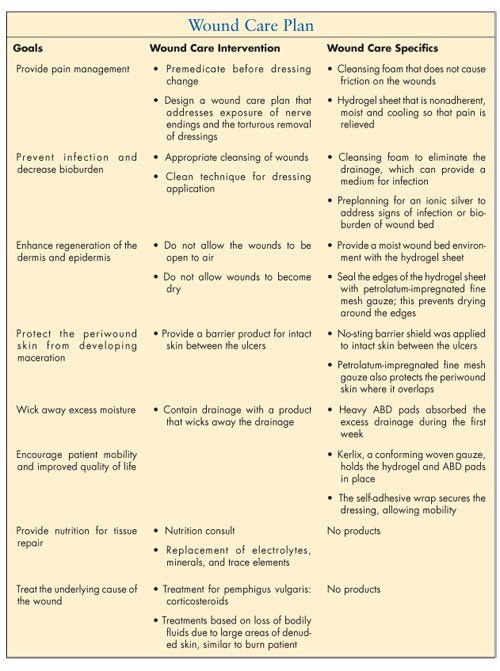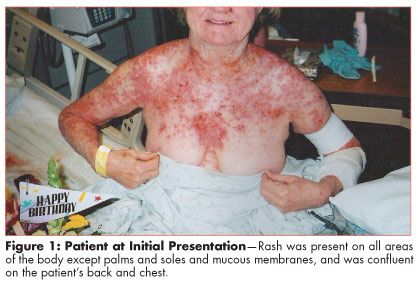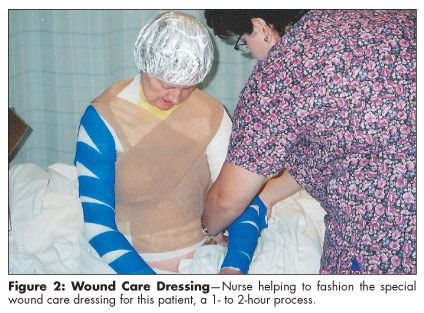Managing Painful Surface Wounds
Gina, age 9, and Rosemary, age 66. They had different cancers, but developed similar skin ulcers over their entire bodies. Gina's wounds were open to air for 4 weeks. Her pain was severe. Two weeks after starting wound care, Gina allowed us to take pictures of her wounds. We promised to teach doctors and nurses how to care for her wounds. Unfortunately, Gina died. The pictures were lost. A year later, Rosemary was admitted with a similar skin condition and allowed us to photograph the progression of her wound care. Our promise to Gina is now kept. Here we describe the wound care plan necessary to relieve the pain and discomfort of partial-thickness wounds from dermatological conditions in oncology patients.
This is the story of Gina, age 9, and Rosemary, age 66. They had different cancers, but developed similar skin ulcers over their entire bodies. Gina's wounds were open to air for 4 weeks. Her pain was severe. Two weeks after starting wound care, Gina allowed us to take pictures of her wounds. We promised to teach doctors and nurses how to care for her wounds. Unfortunately, Gina died. The pictures were lost. A year later, Rosemary was admitted with a similar skin condition and allowed us to photograph the progression of her wound care. Our promise to Gina is now kept. Here we describe the wound care plan necessary to relieve the pain and discomfort of partial-thickness wounds from dermatological conditions in oncology patients.

The Wound Care Myth
Chemotherapy, radiation, and immune suppression from cancer treatment may contribute to superficial denudation of skin. Since the wounds are only on the surface, the myth of "leaving it open to air" prevails. However, as the original research of George D. Winters (1962 and 1963) indicates, partial-thickness wounds require a nonadherent moist dressing covering them. In addition, the nerve endings at the surface of the skin need to be covered with a moist environment. Otherwise, the nerve endings signal to the brain that the skin integrity is disrupted and that the body is open to further invasion and infection. It is as though the nerve endings are exposed, untethered, electrical wires emitting sporadic intense charges. The pain is excruciating.
Case Study
A 66-year-old female recently treated with chemotherapy for chronic lymphocytic leukemia was referred to the skin care nurse (certified wound care nurse), who found the patient in bed without a dressing. The patient's body was covered with blisters and partial-thickness wounds from her face down to her feet (Figure 1). The serous sanguineous fluid drained onto the bed linens, causing excruciating pain with the constant cycle of being stuck to the sheets, and unstuck. The patient agreed to try a new wound care plan and allowed progressive photographic documentation. The eventual diagnosis was pemphigus vulgaris, an autoimmune disease with manifestations of skin blisters and surface ulcers. The premise of care for this patient is based on burn therapy.

Innovative Clinical Approach
The goals of wound care management were identified as follows:
• Relieve severe pain;
• Prevent infection and decrease bioburden;
• Enhance regeneration of the dermis and epidermis;
• Protect the periwound skin from maceration;
• Encourage patient mobility and quality of life;
• Provide nutritional support for tissue repair; and
• Treat the underlying cause of the wound.
All dressing products are nonadherent. The wound care consisted of a daily dressing utilizing a foaming skin care wash, a nonsting skin barrier to protect the intact skin, and hydrogel sheets to provide a moist environment. An advanced ionized silver wound-care product, in the form of a gel or powder, was considered a possibility in the event of a wound infection. Xerofoam gauze, an optional product, was applied over the hydrogel sheet to prevent the sheet from drying out, and to stabilize it. Initially, large abdominal dressings were applied over the Xerofoam gauze, to absorb the drainage. Various types of stretch bandage and/or net dressings were used to secure the dressing. Because the patient's entire body was involved, it was as though an outfit was being "fashioned" for her (see Figure 2).

Daily Wound Care Plan
Every wound care plan is individualized to the patient and the wound. The following is a summary for this patient.
• Clean the wound with a foaming skin care wash, which looks similar to shaving cream. This is the only wound product that allows cleaning of the wound without pain, as it is nonabrasive. It can be applied directly to wounds and then gently rinsed off. This patient was able to shower. After showering, she was wrapped in a warm bath blanket to maintain her temperature, which is conducive to wound healing.
• Protect the periwound skin with a no-sting skin barrier. This is similar to applying a thin film on the intact skin as a shield against excessive moisture. No-sting is painless because alcohol is not an ingredient. It comes in a spray or in a pad form.
• Provide a moist environment with a hydrogel sheet. This is gelled water formed into a flat dressing. It usually comes in a 4 inches by 4 inches size, or 6 inches by 8 inches. It is covered with two films. One film is removed and the sticky side is placed on the wound bed.
• An optional step is placement of a fine mesh nonadherent gauze which is impregnated with petrolatum and 3% bismuth tribromophenate. (The brand name is Xeroform.) This gauze secures the hydrogel and provides additional protection of the periwound skin.
• If wound drainage is excessive, then heavy ABD pads (cotton dressing pads) can be applied to wick away the drainage.
• The entire dressing was secured first with Kerlix, a conforming, 100% woven gauze. A self-adhesive wrap with minimal stretch provided the finishing touch to the dressing, allowing the patient mobility and improved quality of life. An outfit that allowed for movement was "fashioned" for the patient.
Outcome Measurements
Three methods were utilized:
• Pain management assessed by the Verbal Numeric Pain Scale;
• Pain management evaluated by amount of pain medication received; and
• Wound healing, determined by progressive photographic documentation.
Verbal Numeric Pain Scale
• Initially the patient reported her pain level as 10 before the dressing was applied. After the dressing was applied, the patient reported a pain level of 1.
• Several days later, the pain level advanced to between 6 and 8 after the morning dressing was applied. The nurses requested an additional dressing change before bedtime in lieu of giving narcotics. Although this dressing process required two nurses working between 1 and 2 hours, the nurses recognized that the wound care provided more effective pain relief than a narcotic.
• The patient's pain ranged between 1 and 5 throughout the 24 hours, with occasional B.I.D. dressings.
• Zero was the most frequently rated pain level.
• The average pain scale report for wounds throughout the hospital stay was 2.6.
Pain Medication
• Pain medication usage was decreased.
• Intravenous morphine was no longer required.
• Pain was managed with one to three Vicodin (hydrocodone bitartrate and acetaminophen) a day.
• Benadryl (diphenhydramine hydrochloride) was also used for itching.
Patient's Comments About Pain (from medical record)
• "Pain improves with medication and dressing changes."
• "Pain worsens when dressing dries [out]."
• "Pain improves with dressing change and Vicodin."
• "Pain worsens when [wound] is touched or open to air."
Photographic Documentation of Wound Healing
• Sequential photographs revealed complete wound healing in 3 months (Figure 3).
• Partial-thickness wounds healed without scars.
• No skin infections occurred.

Discussion
The oncology patient has unique skin care issues, owing to the therapies received. This case study illustrates skin effects that may be encountered. Entire body sloughing of patients' skin is not unfamiliar to the oncology nurse. Principles of burn care are applicable. The wound care plan focuses on reducing pain, preventing infection by gentle cleansing, and preventing scarring by providing a moist environment. Nutrition is a prime aspect of care, owing to the loss of protein and other essential components in the serous sanguineous drainage. Finally, the cases of both Rosemary and Gina illustrate the importance of keeping the skin surface moist and not open to air in healing and pain management.
References:
Doughty D: Four steps to successful chronic wound management. Home Healthc Nurse 22(4):264-267, 2004.
Lazarus GS, Cooper DM, Knighton DR, et al: Definitions and guidelines for assessment of wounds and evaluation of healing. Arch Dermatol 130(4):489-493, 1994.
Mertz P: Occlusive wound dressings to prevent bacterial invasion and wound infection. J Am Acad Dermatol 12(4):662-668, 1985.
Metzger S: Clinical and financial advantages of moist wound management. Home Healthc Nurse 22(9):586-590, 2004.
Nemeth A, Eaglstein W, Taylor J, et al: Faster healing and less pain in skin biopsy sites treated with an occlusive dressing. Arch Dermatol 11(127):1679-1683, 1991.
Ovington L: Hanging wet-to-dry dressings out to dry. Adv Skin Wound Care 15(2):79-84, 2002.
Winter G: Formation of the scab and the rate of epithelization of superficial wounds in the skin of the young domestic pig. Nature 193:293, 1962.
Winter G, Scales J: Effect of air drying and dressings on the surface of a wound. Nature 197:91, 1963.
Femiano F: Pemphigus vulgaris: Recent advances in our understanding of its pathogenesis. Minerva Stomatol 56(4):215-223, 2007.
Oncology Peer Review On-The-Go: Cancer-Related Fatigue Outcome Measures in Integrative Oncology
September 20th 2022Authors Dori Beeler, PhD; Shelley Wang, MD, MPH; and Viraj A. Master, MD, PhD, spoke with CancerNetwork® about a review article on cancer-related fatigue published in the journal ONCOLOGY®.